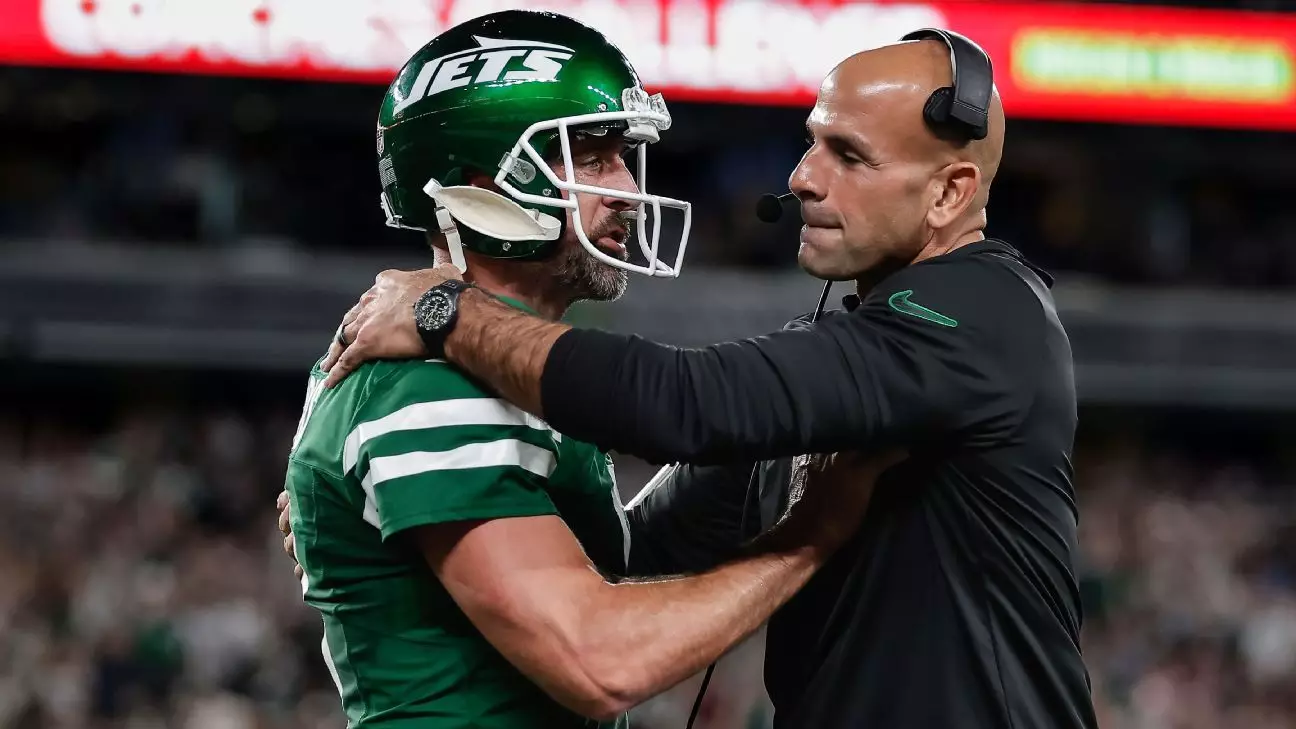In a remarkable display of skill and resilience, Aaron Rodgers, the venerable quarterback of the New York Jets, delivered a performance that defied expectations in a 24-3 victory over the New England Patriots at MetLife Stadium. Amidst mounting pressure and scrutiny, not only did Rodgers conquer the field with his precise passing—totaling 281 yards and two touchdowns—but he also injected newfound energy into the Jets’ gameplay as they secured their second consecutive win. This match represented a significant turning point, capturing the attention of fans and analysts alike, presenting a masterclass of quarterback play.
Rodgers’ execution was not merely a product of statistics; it signified a reclamation of his past glory. With each play, he displayed remarkable athleticism and decision-making, managing to elude defenders and extend plays, showcasing a mobility that many had deemed largely absent due to age and prior injuries. The quarterback completed an astounding 27 of 35 throws, affirming his resurgence amidst whispers of decline. This match marked him as only the fourth quarterback in NFL history to record a completion percentage of 75% while throwing for over 250 yards at the age of 40 or older—a feat that included legends like Tom Brady and Drew Brees.
Perhaps one of the most talked-about moments from the game wasn’t a highlight on the scoreboard but rather an interaction between Rodgers and head coach Robert Saleh. Following a monumental touchdown run by Breece Hall, which extended their lead to 14-0, the sidelines witnessed a brief but telling episode between the two. Rodgers, opting for a more reserved approach to early celebrations, rebuffed Saleh’s attempt at a hug with a light shove, signaling that the game was far from over. While the pair later downplayed the incident with humor, this episode revealed the competitive spirit and high expectations that permeate their locker room.
Rodgers later remarked that such moments of exuberance weren’t typical for him, reinforcing the notion that his mentality remains laser-focused on the task at hand. Saleh indicated that their prior discussions about the importance of maintaining a lead contributed to this moment of confusion. This minor sideline drama encapsulated the relationship of athletes striving for excellence amidst fleeting moments of victory—a juxtaposition reflective of the game’s intensity.
As the game progressed, it became evident that the emotional weight of the night was not lost on either player—or fans. For Rodgers, this game held more significance than just a victory; it was an opportunity to return to the very field where he tragically ended his previous season due to an Achilles injury. Standing amidst chants from the crowd, he could feel the pulse of a fanbase eager to embrace a symbol of hope and resilience.
His connection with fellow teammates, particularly Allen Lazard, who had played with him during their time in Green Bay, also underscored the realities of professionalism in the NFL. After a touchdown reception, Lazard acknowledged the importance of the moment, understanding the significance of Rodgers’ return: “To be able to make it back here, being 40 years old… I’m very proud of him.” This camaraderie reflects the unity required to advance in a sport marked by fierce competition and rugged physicality.
Rodgers’ performance was not simply a matter of athletic prowess; it was also intertwined with strategic decisions that highlighted his veteran acumen. He expertly navigated through plays, displaying a keen understanding of the game that belied his years. On a notable run-pass option play, he executed a precision pass to Garrett Wilson, illustrating his ability to harness the moment and respond under pressure. This connection, especially after Wilson’s prior struggles, breathed new life into their offense and established a rhythm that proved pivotal to the Jets’ success.
By distributing the ball among eight receivers and directing multiple scoring drives, Rodgers epitomized the role of a quarterback as a leader, orchestrating plays while dynamically adapting to unforeseen challenges during the game. His misfires transformed into moments of growth, where lessons learned become part of the evolving narrative for the Jets.
As the Jets contemplate their trajectory following this refreshing victory, they stand at a crucial juncture. With a solid performance under his belt and a renewed sense of purpose, Rodgers has set the tone for what is possible as the season progresses. The emotional echoes of this game will resonate beyond just the scoreboard; it marks the re-emergence of a formidable quarterback leading a team hungry for success in a fiercely competitive league.
In sum, this captivating game against the Patriots showcased not only Aaron Rodgers’ skill as a quarterback but also the power of tenacity, teamwork, and the human spirit—elements essential for achieving greatness in the world of sports.


Leave a Reply